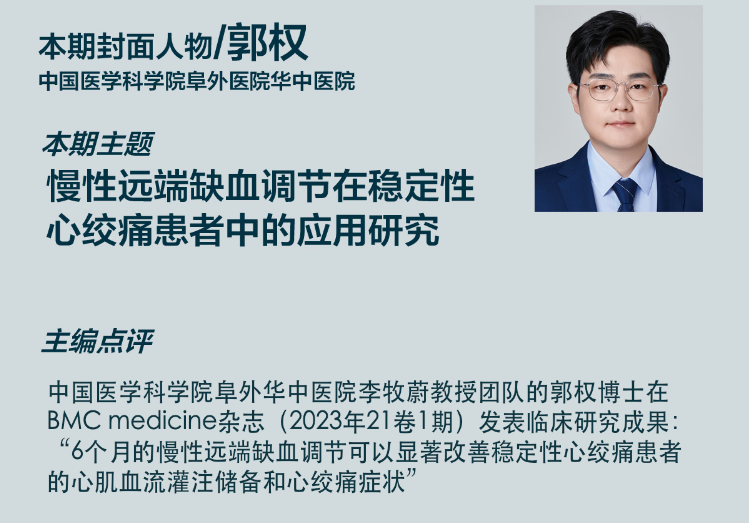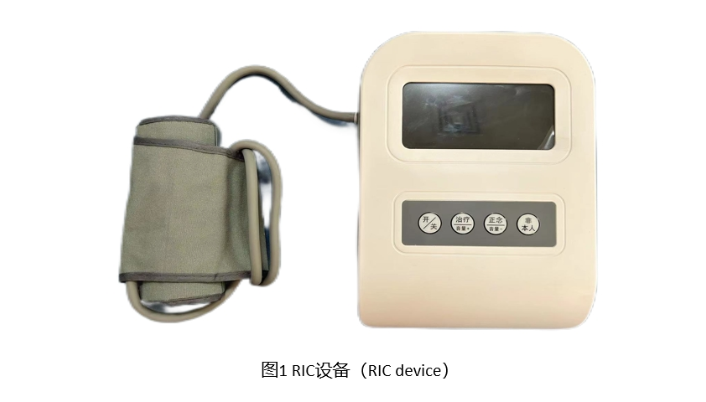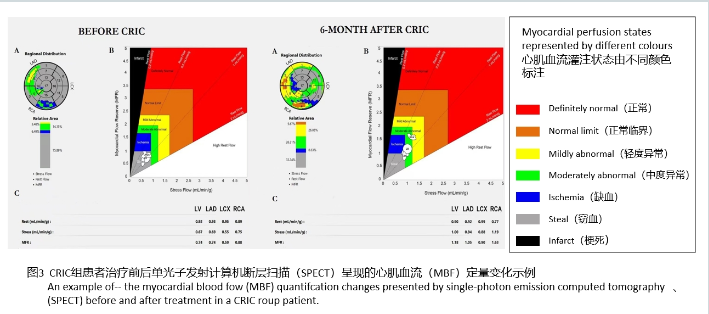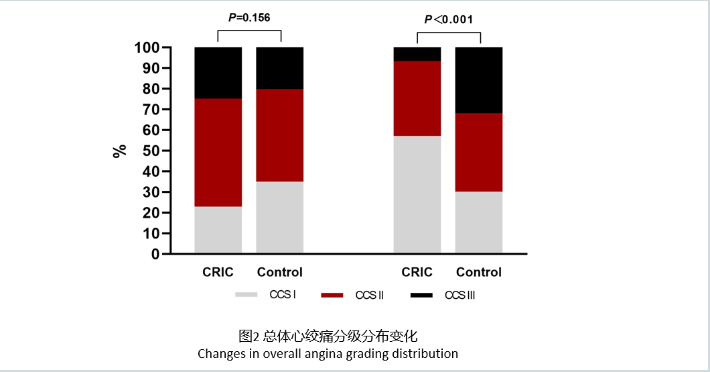
研究主要内容概括:
本研究为一项随机对照、真假干预的临床验证研究,以评估6个月的慢性远端缺血调节(CRIC)对改善稳定性心绞痛(CSA)患者心肌灌注及心绞痛症状的有效性和安全性。
该研究共纳入了220名患者并随机分为试验组与对照组,分别接受了6个月的随机真假慢性远端缺血调节治疗(图1)。研究主要终点为单光子发射计算机断层扫描(SPECT)检测的心肌血流储备(MFR)的变化值差异。次要终点为心绞痛症状的改善率(使用CCS心绞痛分级、西雅图心绞痛评分和6分钟步行试验距离来评价)和心脑血管不良事件(MACCEs)发生率。研究结果证明了6个月的CRIC干预可以明显改善CSA患者的MFR(图2)、心绞痛症状(图3)及运动耐量,且不增加MACCEs的发生率,治疗耐受性良好。CRIC的效果可能是通过改善患者心脏的微循环功能,促进血管新生,降低静息状态下心肌的耗氧量。这种无创、安全、有效、简单的干预方式可能成为CSA患者的新型治疗手段。
研究评论:
我国冠心病的患病率和死亡率持续上升。尽管冠状动脉介入技术及搭桥技术的不断进步与发展,临床中依然存在着大量的不能进行介入或搭桥手术的患者以及介入或搭桥失败的患者。这些晚期冠心病患者即使接受了最佳的药物治疗仍不能解决其痛苦而严重影响生活质量和预后,是临床是十分棘手的问题。反复发作心绞痛和心力衰竭多次住院,给个人和社会带来沉重的精神和经济负担,严重影响国民经济发展。因此,该类患者的治疗是临床实践中极具挑战性的难题,寻找其有效的治疗方法具有重要的临床实用价值。
李牧蔚教授团队通过近几年对该类患者的临床研究发现,当无法对心外膜血管进行干预时,在冠脉微循环层面,通过改善其功能,增加心肌灌注量,能明显改善患者心绞痛症状及心功能状态。于是提出了慢性远端缺血调节(CRIC)通过改善冠脉微循环来改善心肌缺血的概念,通过开放冠脉微血管及新生血管的生成,增加心肌的供血,本课题验证了该概念的可行性及临床实用性。团队中郭权博士后以第一作者将该研究结果2023年发表在《BMC medicine 2023,21:324》杂志上。该研究为晚期冠心病患者找到了一种安全有效的治疗方法。这种方法与传统的药物、手术等治疗方法迥然不同,无创、安全、有效、简单的干预方式解决了患者心绞痛症状,避免了复杂手术带来的风险,减低了多次住院的医疗费用。
Summary of Main Research Content:
This study was a randomized, controlled, sham-intervention, proof-of-concept trial and the aim of this study was designed to evaluate the efficacy and safety of six months of chronic remote ischemic conditioning (CRIC) in improving myocardial perfusion and angina symptoms in patients with chronic stable angina (CSA). A total of 220 patients were enrolled and randomly assigned to either the intervention group, receiving CRIC for six months(Figure1), or the control group, receiving sham-CRIC treatment.
The primary endpoint was the change in myocardial flow reserve (MFR) as measured by single-photon emission computed tomography (SPECT). Secondary endpoints included the improvement rate of angina symptoms (assessed by CCS angina classification, Seattle Angina Questionnaire, and six-minute walk test distance) and the incidence of major adverse cardiovascular and cerebrovascular events (MACCEs). The results demonstrated that six months of CRIC significantly improved MFR(Figure2), angina symptoms(Figure3), and exercise tolerance in CSA patients without increasing the incidence of MACCEs, with good treatment tolerability. The beneficial effects of CRIC may be attributed to its ability to enhance microcirculatory function, promote angiogenesis, and reduce myocardial oxygen consumption at rest. This non-invasive, safe, simple and effective intervention is a novel therapeutic approach for CSA patients.
Research Commentary:
The prevalence and mortality rates of coronary artery disease (CAD) in China continue to rise. Despite great progresses in drug therapy, coronary artery interventions and bypass surgery, there remains a significant number of patients who are either ineligible for these procedures or have experienced procedural failure. These late-stage CAD patients, even with optimal medical therapy, often suffer from persistent symptoms that severely impact their quality of life and prognosis, presenting a formidable clinical challenge. Recurrent angina and heart failure lead to frequent hospitalizations, imposing a substantial psychological and economic burden on individuals and society, ultimately hindering national economic development. Thus, finding effective treatment options for these patients is of urgent and significant clinical value.
Professor Li Muwei’s team has conducted extensive clinical research on such patients over the past few years. Their findings indicated that when epicardial coronary arteries are not able to intervention, improving microcirculatory function can significantly enhance myocardial perfusion and alleviate angina symptoms. Based on this concern, the concept of CRIC was proposed to improve myocardial ischemia by enhancing coronary microcirculation and promoting neovascularization, thereby increasing myocardial blood supply. This study has validated the feasibility and clinical utility of this concept. The research findings, with Dr. Quan Guo as the first author, were published in the BMC Medicine in 2023. This study offers a safe, effective and simple treatment method for late-stage CAD patients, distinct from traditional pharmacological or surgical approaches, anesising angina symptoms, avoiding the risks associated with complex surgeries, and reducing the costs of recurrent hospitalizations.

远端缺血调节(RIC)工具由左侧的压力袖带和右侧的控制器组成,控制器内嵌了RIC程序,并由后台远程控制压力值。慢性远端缺血调节(CRIC)组患者为每天2次RIC治疗,每次4个周期,每个周期包含5分钟的加压(200mmHg)和5分钟的放松(0mmHg),对照组患者加压时袖带压为60mmHg。
The remote ischaemic conditioning (RIC) device consists of a pressure cuff on the left side and a controller on the right side, which is embedded with the RIC programme and remotely controls the pressure values from the back office. Patients in the chronic remote ischemic conditioning(CRIC) group were treated with 2 RIC sessions per day for 4 cycles each consisting of 5 minutes of pressurisation (200 mm Hg) and 5 minutes of relaxation (0 mm Hg), and patients in the control group had a cuff pressure of 60 mm Hg at the time of pressurisation.

A部分:血流状态极图,用条形图表示每种血流状态的程度;B部分:血流图;C部分:全心及左心室各部分的静息MBF和负荷MBF以及心肌血流储备(MFR)的定量。该患者在接受6个月的CRIC治疗后,MFR从0.74提升至1.18.
Part A: Blood fow status polar map, with a bar graph to represent the extent for each flow status; Part B: The blood fow diagram; Part C: Quantifcation of rest MBF and stress MBF and myocardial fow reserve (MFR) globally and in individual parts of the left ventricle.This patient's MFR improved from 0.74 to 1.18 after 6 months of CRIC treatment.

左右两侧分别代表入组时和随访时心绞痛加拿大心血管协会(CCS)分级的分布对比。在入组时两组患者CCS分级相似,在随访时候CRIC组CCS III级占比较对照组明显减少,CCS I级占比明显增加。
The left and right panels compare the distribution of angina Canadian Cardiovascular Society (CCS) grades at enrolment and follow-up. At baseline, the CCS grades were similar in both groups, and at follow-up there was a significant decrease in the proportion of CCS grade III and a significant increase in the proportion of CCS grade I in the CRIC group compared with the control group.
郭权,医学博士,住院医师,博士后在站研究人员。 专业方向:冠心病的诊断与治疗; 擅长领域:冠状动脉的介入诊疗技术,能独立完成左主干、真分叉、CTO、钙化病变等各种复杂手术。 参与了三项中国专家共识的写作工作。参与国家重点研发计划子课题、国家自然科学基金及多项省部级课题科研工作。
邮箱:xinyiguoquan@163.com
Quan Guo, Doctor of Medicine, Resident Physician, Postdoctoral fellow Specialization: Diagnosis and treatment of coronary artery disease Dr. Quan Guo is skilled in interventional techniques for coronary artery diseases, including complex procedures involving the left main artery, true bifurcations, chronic total occlusions (CTO), and calcified lesions. Dr. Guo has contributed to the writing of three Chinese expert consensus and participated in sub-projects of national key R&D programs, National Natural Science Foundation projects, and several provincial and ministerial-level research projects.
Email: xinyiguoquan@163.com